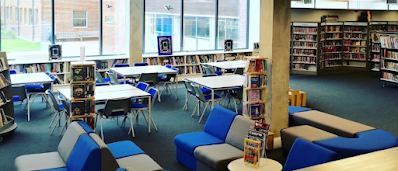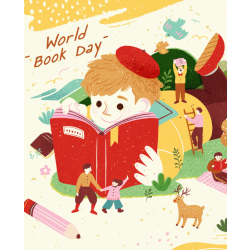READING FOR PLEASURE STATISTICS - By Lucas Maxwell
It's the time of year when I run reports and look at borrowing statistics for the school. I want to stress that the info I provide on this topic is not meant to act as a competition or to brag about borrowing numbers. I'm also not saying that if you don't do the things I list you won't have good borrowing stats. I'm just trying to put together reasons why I think our borrowing stats are the way they are.
I am genuinely trying, as all school librarians are, to increase the number of books I put into the hands of the students on a daily basis. I'm also looking at what books are the most popular and why.
I presented some of my findings to our board of governors which focused on a lot of positive things like:
We average 750 visits to the library per day.
Our clubs were run over 370 times during the school year (an average of 2 clubs per day) with a total attendance of 6,303 students.
In Sept the National Literacy Trust published a report stating that 43.4% of children and young people aged 8-18 said they enjoyed reading in their free time. This is the lowest level since a survey like this was completed back in 2005.
I ran a survey of my own for ages 11-13 (close to 900 students) within the school. I adapted the surveys provided by The Open University.
I also ran my own borrowing reports using our online catalogye through AccessIT, which I highly recommend if anyone is looking for a new cataloguing system.
My surveyed showed that 60% of students in the school aged 11-13 said they either "liked" or "loved" reading for pleasure on their own time.
10% said they did not like reading at all. I took this as a huge win with the caveat that I would target that 10% in the new school year.
30% said they had no opinion about reading one way or another. However, it was interesting to see that of this 30% who were "meh" about reading, a large number of them (70%) said they preferred audiobooks or said things like "I enjoy reading when it's the right book" or "I have to be in the right mood to read" or "I like to read I just can't sit still long enough to do it."
This is very interesting to me because I would place those students in the "I like reading" category due to the asteriks' after their choice.
Of the 10% who said they did not like to read, 95% said the reason was that it was "boring" although a few did say it was because they could not find any good books which is mind blowing to me as I know how much work I put in to promoting books for everyone. It was still a wake up call that I needed to do more.
I need to find out why they think it's boring, and try hard to find books that will catch their attention. I've had success in the past by creating displays that focus on video games and sports, books like The Crossover, Long Way Down and Kick are all good examples of books that have broken through the "boring" barrier.
We had a lot of books borrowed in the school year, close to 11,000, which is great for us. Of the top 10 most popular books, 9 of them are from our internal book award, The Bookling, which highlights great books that are "under the radar" and not ones you'll find on the shelves at Tesco.
Also, 5 of the 10 most popular books are from authors who visited the school which is a testament to the power of author visits. I wrote more about the impact author visits have here.
Looking at borrowing stats, 7 of the top 10 borrowers are boys, which is a new phenomenon.
Boys are also borrowing 10% more than girls in 2023/24. This is also completely new, at Glenthorne, boys typically borrow 3-4% more than girls but never 10%.
The negative is that there is a massive drop-off in borrowing between Year 9 and 10. Year 9 are borrowing "ok-ish" but when they hit Year 10 it plummets off a cliff. I need to work on this more in the new year and my goal is to bring Year 10s in once a half-term for a library lesson and to borrow books.
Here are the reasons why the statistics look the way they do in our school (in my opinion):
We have a dedicated library space and a librarian.
The Great School Libraries research campaign shows that libraries and librarians in secondary schools are dropping. The fact that we are open every day of the week, ten hours per day, means a lot. We average around 750 visits a day and offer a wide range of activities. This helps massively in creating a lifelong love of reading because to put it plainly, the students at the school are immersed in it every day.
We have a collection of books that reflects the student population.
Using the very simple anaolgy that books can act as mirrors and windows, I've built a collection where (hopefully) every student can put themselves in the experience of others and of course see themselves as the heroes in the stories they read. This means we have built a massive comic book and manga collection, non-fiction and quicker reads using great providers like Barrington Stoke and Badger Learning.
Have a student that loves minecraft? I've got a series of comic books that combines Minecraft and Dungeons & Dragons-esque adventures. I also have a student that loves flags, is obsessed with them, so I bought a bunch of flag books. Simple, except it isn't if you don't have a librarian with a healthy budget and somewhere to put said books.
In my opinion, teachers cannot do the job of a librarian, and they shouldn't be asked to. We know that 1/3 of teachers in the UK are experiencing burnout, over 50% say they are losing sleep and four in five are stressed (source). The job of the librarian is to have these kinds of conversations with students so they can create a collection around their likes, hobbies and future goals.
We get the entire school involved.
All teachers are invited to our library programmes, teachers take part in reading challenges over the half-term breaks, I put books into the hands of teachers over the summer, we run reading based competitions, the list goes on. This is how we create a culture of reading - through enthusiastically promoting amazing books every single day but again, no one in the school has time to do this other than the librarian in my opinion.
We try new things constantly
We run a lot of clubs, and even better, the older students run a lot of clubs on their own. We also do a fair number of events and activities on Saturdays through Mock Trial, Debate, Model UN, Dungeons and Dragons, ComiCons and more. This means we area bringing in new faces all the time, students who wouldn't traditionally use the library but might come in if they find out one of their friends is singing in the Open Mic at lunch or if they realise we paint Warhammer figures after school on a Wednesday.
Most of these programmes are suggested by the students, I try to start programmes that are relevant to their interests and quite selfishly, things that 11 year old me would want to do if I'd had a good library in my school growing up.
We have bi-weekly library lessons
This should have been at the top, really. These lessons, aimed at ages 11-13, are absolutely crucial in establishing a culture of reading in the school.
It means that on some days I am running five lessons, reaching 150 students where I can read aloud, promote library events and activities and have the students spend time browsing and borrowing. This translates to a huge increase in engagement in all areas of the library. In these lessons we read our own book together silently for 15-20 minutes while students in small groups browse for new books one table at a time. After that, I run an activities, a whole range of these activities can be found here.
Reading aloud has been huge, as has been ensuring boys keep reading. Boys usually drop off the reading for pleasure cliff around year 8 or 9 but I've been able to keep them on board with our Manga Club and Manga collection. You can find a list of Manga Club activities here.
Yes it's a lot of work but I feel that these are the reasons why we have such a positive attitude towards reading. It's an friendly yet persistent approach to getting books into the hands of students and getting them to come back for more with engaging and fun activities with the whole school in mind.









